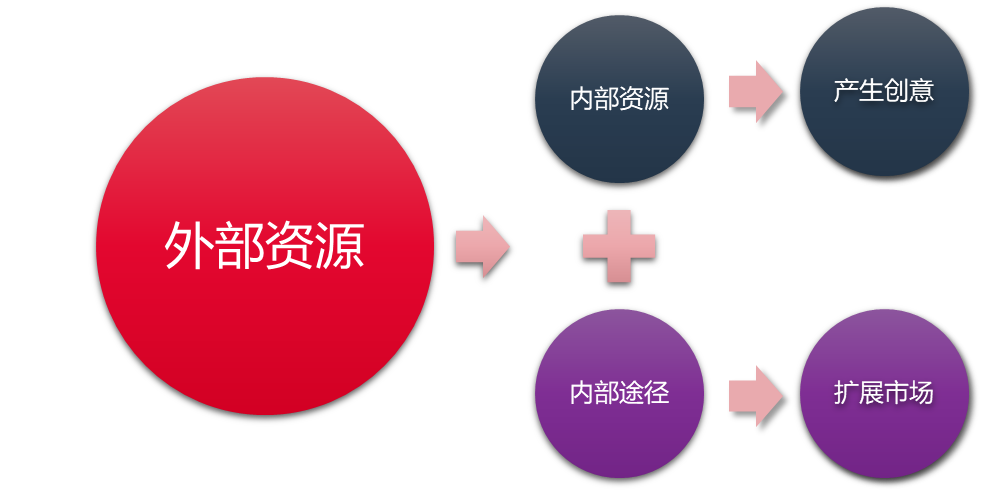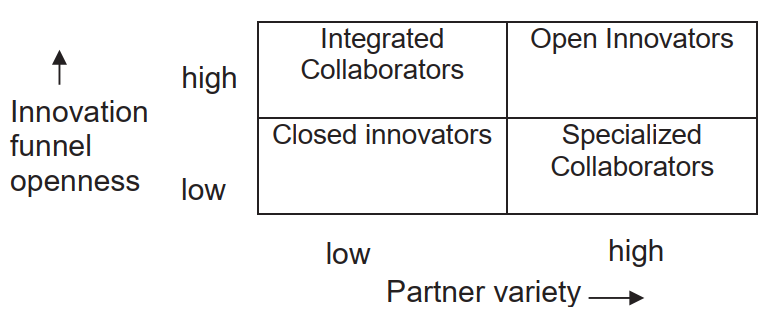90%的创新,来源于开放式创新
—— 保洁(P&G)
采用众包或者开放式论坛,让使用者参与到产品创新当中
切萨布鲁夫,2003
- 定义:通过有目的知识流入和流出加速内部创新,并利用外部创新扩展市场。
- 原因:在一个知识广泛分散的世界里,组织不能完全依靠自己完成全部研究工作。应当考虑从其他组织购买流程或发明,获取可使用许可,比如专利。组织与外部环境边界可以渗透,技术能够在公司内外转移。不能用于公司业务的内部发明应当被转移到公司外部(比如通过授权、合资、剥离等方式)
- 企业资源有限
- 知识去中心化
- 知识传播速度快而广
- 不能用的发明,应当转移其他公司
- 包括:
- 利用外部资源和内部资源产生创意
- 利用外部途径和内部途径扩展市场


| 封闭式创新 | 开放式创新 |
|---|---|
| 领域中最聪明的人为我们工作 | 并不是所有聪明人都为我们工作,我们需要跟内外部聪明的人合作 |
| 从R&D中盈利,我们必须自己开发和创造,开发产品并把它推向市场 | 内部R&D工作需要或者有权利分享外部R&D工作创造的巨大财富 |
| 我们自己进行研究,就能首先将新产品引入市场 | 不是非要自己研究才能从中获利 |
| 将创新引入市场的企业必将胜利 | 建立一个更好的商业模式要比把创新引入市场更重要 |
| 如果我们创造了行业中最多最好的,那么我们一定能在竞争中取胜 | 如果我们能充分利用企业内外的所有创意,那么我们一定能成功 |
| 我们应当牢牢控制我们的知识产权,那么竞争对手就无法从我们发明中获利 | 我们应从其他利用我们只是产权的公司中获利,同时也应当购买别人知识产权并从中获利 |
Foundations of Open Innovation
- Open Innovation (OI) is defined is the strategy adopted by an organization whereby it actively seeks knowledge from external sources through alliances, partnership and contractual arrangements to complement and enhance its internal capability in pursuit of improved innovation outcomes. These innovation outcomes may be commercialized internally, through new business entities, or through external licensing arrangements.
- OI can deliver many benefits, but applying it is challenging. Figure 1.25 summarizes some potential benefits as well as challenges of applying OI, organized around the six principles of OI (Tidd and Bessant, 2013).
| Principle of OI | Potential benefit | Challenges in OI application |
| —- | —- | —- |
| Tap into external knowledge, e.g., through
customer contests, university partnerships, and other collaborations | Increase pool of knowledge
Reduce reliance on limited internal knowledge | How to search for and identify relevant knowledge sources
Breaking down traditional internal views on innovation | | Acquire external R&D | Can reduce the cost and uncertainty associated with internal R&D and increase depth and breadth of R&D | Less likely to lead to distinctive capabilities and more difficult to differentiate
External R&D may also possibly be competitors | | Do not have to originate research in order to profit from it | Reduce cost of internal R&D, more resources applied to
external search strategies and relationships | Need sufficient internal R&D capability in order to identify, evaluate and adapt external R&D | | Building a better business model is superior to being first to market | Greater long-run profitability and success | First-mover advantages depend on technology and market context and may be difficult to overcome | | Best use of internal and external ideas, not generation of ideas | Better balance of resources to search and identify ideas, rather than generate | Many companies are better at generating superficial ideas than finding the long-term winners
The cost of evaluation is often high when sifting through potentially thousands of ideas | | Profit from others’ IP (inbound OI) and others’use of our IP (outbound OI)
| Gets intellectual property (IP) in the hands of those companies best equipped to commercialize | Conflicts of commercial interest or strategic direction
Negotiation of acceptable forms and terms of IP licenses |
The benefits and challenges of Open Innovation. Adapted from Tidd, J. and Bessant (2013)
Open Innovation model types
- Searching for and then working with external parties (be they customers, suppliers, competitors, or research institutions such as universities) is labelled as “inbound open innovation.” Organizations can become different types of “inbound open innovators” depending on the number/types of partners with which they work (aka “partner variety”) and the number/types of phases of their innovation process that they “open” to external parties (aka “funnel openness”) (Tidd and Bessant, 2013). Figure 1.26 summarizes the four models of OI according to the level of funnel openness and the partner variety. In the bottom left of Figure 1.26 there are closed innovators who have very low funnel openness and a low variety of partners. In the top right is the other extreme of open innovators who have a high level of funnel openness and a high variety of partners.

Open Innovation model types
- Organizations must exercise caution when deploying resources for inbound innovation. Research shows that at low levels of openness (being generally closed to outside ideas) and very high levels of openness (considering ideas from a vast array of sources), innovation performance seems to suffer, while firms with a moderate amount of openness showed superior product and process performance.
- The main success factors and appropriate managerial styles differ for these different types of open innovators (Tidd and Bessant, 2013). The main success factors for each of the four OI models summarized in Figure 1.27 and the associated management style are presented in Figure 1.28.

Mechanisms for participation in Open Innovation
For further reading on Open Innovation, refer to Noble et al. (2014)
Open Innovation examples
- Open Innovation is used by many organizations, including a number of PDMA’s Outstanding Corporate Innovation (OCI) award winners. The 2015 OCI award winner, Novozymes, a leader in enzymes and microbial technologies, uses OI in various phases of the innovation process. They are particularly active in crowdsourcing in the idea generation stage: they collect ideas online for two weeks, screen these ideas and then mature the selected ones for one month. These matured ideas are then pitched to management as New Lead Project Proposals.
- Offshore Oil Engineering Co., Ltd (COOEC), the OCI winner in 2018, is the world’s leading supplier of KIBS marine energy engineering and provides innovative integrated solutions to petroleum and gas field development.
- COOEC actively uses OI through partnering with university research centers, suppliers, and clients. A final example is the Smart Village initiative in impoverished rural Indian states. A number of companies, many of them competing against each other in other markets, collaborate to empower villagers so that the villagers can join in the supply chain and create a win-win environment both for themselves and for the participating companies (Darwin and Chesbrough, 2016).

